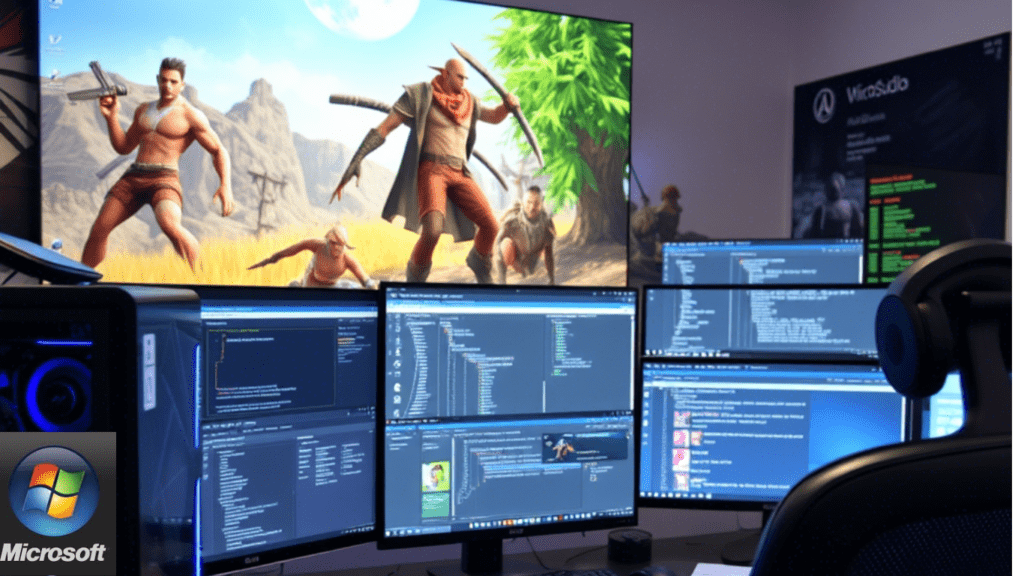AI-powered game development takes a bold leap with Microsoft’s MUSE (Modeling and Understanding of Synthetic Environments). Picture a game world that adapts as you play—each decision you make reshapes the environment, with physics, characters, and logic responding instantly. That’s the promise of Microsoft’s MUSE (Modeling and Understanding of Synthetic Environments). Developed by Microsoft Research, this AI model harnesses a deep-learning framework called the World and Human Action Model (WHAM) to redefine AI-Powered Game Development. Here’s why it’s a breakthrough in the field of AI-powered game Development, revolutionizing the future of interactive entertainment.
What Sets MUSE Apart
Traditional game design relied on preset rules. MUSE takes a different approach, learning from actual gameplay data—visual elements like character movements and controller inputs. This creates dynamic, responsive worlds that appeal to both players seeking immersion and developers building innovative experiences.
1. Adaptive World Generation
MUSE elevates AI-powered game development by generating environments that adjust to player actions. Push over a crate, and nearby objects react naturally, guided by the game’s physics. It shifts the focus from static visuals to interactive, evolving spaces.
2. Real-Time Physics and Logic
How does a ball roll or a character pivot? MUSE’s WHAM analyzes visual and controller data to simulate realistic interactions. This empowers developers to craft complex worlds where every move triggers a logical, believable response.
3. Preserving Classic Games
For fans of retro titles, MUSE offers a fresh take. By studying old gameplay footage and inputs, it recreates classics with added interactivity. This blend of nostalgia and modern tech expands the potential of AI-powered game development.
4. Open-Source Access
Microsoft released MUSE’s model weights and tools as open-source. This move invites developers worldwide to experiment, driving innovation in AI-powered game development. From small studios to VR creators, anyone can build smarter, adaptive experiences.
Inside WHAM: The Core of MUSE
MUSE depends on the World and Human Action Model (WHAM) to drive its innovation. WHAM is a deep-learning framework designed to understand and predict interactions in digital environments.It analyzes two critical inputs: visual data and controller inputs
- Visual Data: Captures environments, character actions, and object behaviors.
- Controller Inputs: Tracks player decisions to predict and mirror human behavior.
By blending these, WHAM generates seamless gameplay sequences that enhance the realism and interactivity of AI-powered game development.
Applications Beyond Gaming
MUSE’s impact stretches past games into diverse fields:
- Digital Twins: Virtual models for urban planning or emergency training.
- VR and AR: Responsive environments for immersive virtual experiences.
- Content Creation: Tools for filmmakers to design realistic virtual sets.
The Future of AI-Powered Game Development
MUSE points to a new era where games evolve with players. Worlds could shift based on choices, narratives could branch dynamically, and classic titles could return with updated visuals and mechanics. Developers gain flexibility; players enjoy tailored adventures.
Why It Matters
Whether you’re a player, developer, or tech enthusiast, MUSE reshapes how we engage with digital environments. It bridges creation and interaction, making AI-powered game development a catalyst for richer experiences.
Conclusion: A New Frontier Awaits
Microsoft’s MUSE signals a turning point for AI-powered game development. Its ability to craft adaptive, intelligent worlds opens doors for creators and players alike. From reviving beloved classics to shaping tomorrow’s VR adventures, MUSE invites us to rethink what’s possible in digital spaces. As this technology grows, it’s worth watching—whether you’re building the next big game or eager to explore it. What’s your take? Could MUSE influence the next game you play or create?

